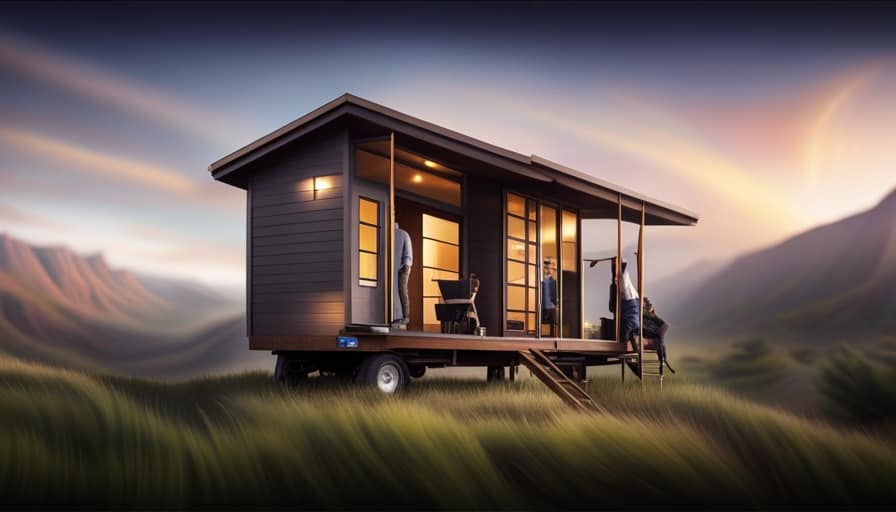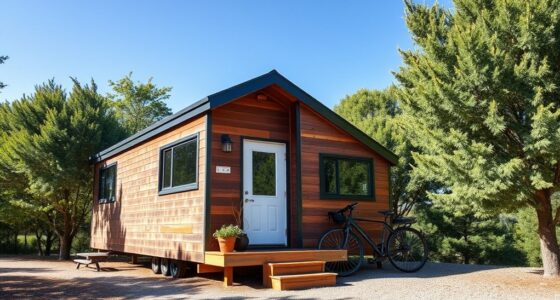Welcome to our ultimate guide on tiny homes!
Just like a master chef needs essential ingredients, every house on wheels must have top-notch features. Think of it as a recipe for the perfect compact living experience.
From smart storage solutions to off-grid power systems, we’ve got you covered. Our knowledgeable and informative guide will walk you through the ten must-have features that will turn your tiny home into a comfortable and stylish haven on wheels.
Let’s get started on serving you the best advice for your tiny home journey!
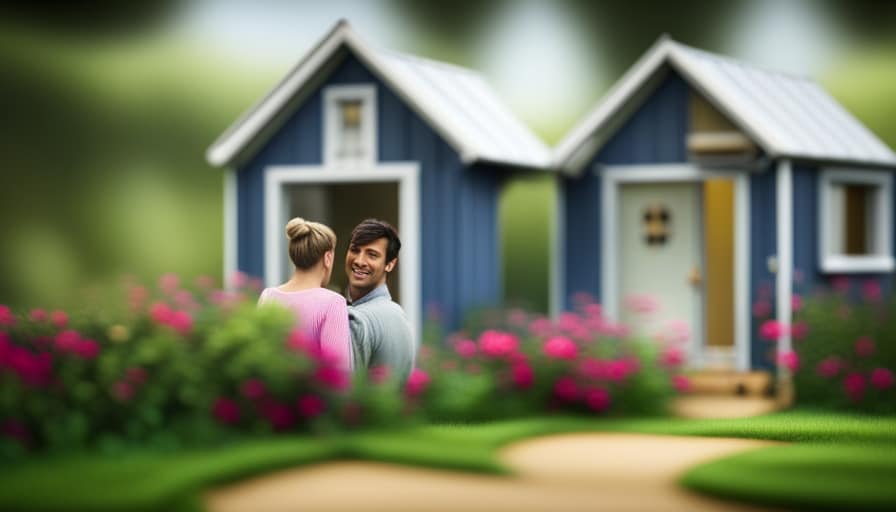
Key Takeaways
- Space-saving and functional design: Utilize hidden compartments, custom-built shelves, and floating shelves to maximize storage space. Incorporate multi-purpose furniture and innovative space-saving designs for maximum functionality.
- Off-grid living and sustainability: Implement solar panels, battery storage, rainwater collection, composting toilets, and eco-friendly materials to live sustainably and minimize resource usage.
- Comfort and climate control: Insulation, energy-efficient windows and doors, programmable thermostats, and comfortable living environment for optimal temperature regulation and energy conservation.
- Construction and mobility: Ensure a strong and durable foundation, quality hardware, reinforced steel frame, lightweight materials, and streamlined shape for stability, easy towing, and maneuverability.
Smart Storage Solutions
We love utilizing innovative storage solutions in our tiny home to maximize space and keep our belongings organized. One of the key features we’ve incorporated into our design is hidden compartments. These cleverly concealed spaces allow us to store items that we don’t use frequently, such as seasonal clothing or extra linens. By utilizing these hidden compartments, we’re able to keep our living area clutter-free and maintain a sense of order in our small space.
Another creative storage solution we’ve implemented is creative shelving. We’ve custom-built shelves that not only serve as storage for our books and decorative items but also double as functional pieces of furniture. For example, our staircase leading up to the loft area also functions as a bookshelf, providing us with easy access to our favorite reads while optimizing the use of space.
Additionally, we’ve utilized floating shelves in our kitchen to store pantry items, keeping them within reach but also displaying them in an aesthetically pleasing way.
Compact and Functional Kitchen
Our compact and functional kitchen includes all the necessary appliances and features to make cooking a breeze in our tiny home. We understand the importance of maximizing space while still having access to all the tools needed to prepare delicious meals. With our innovative storage solutions and carefully selected compact kitchen appliances, we’ve created a kitchen that’s efficient and practical.
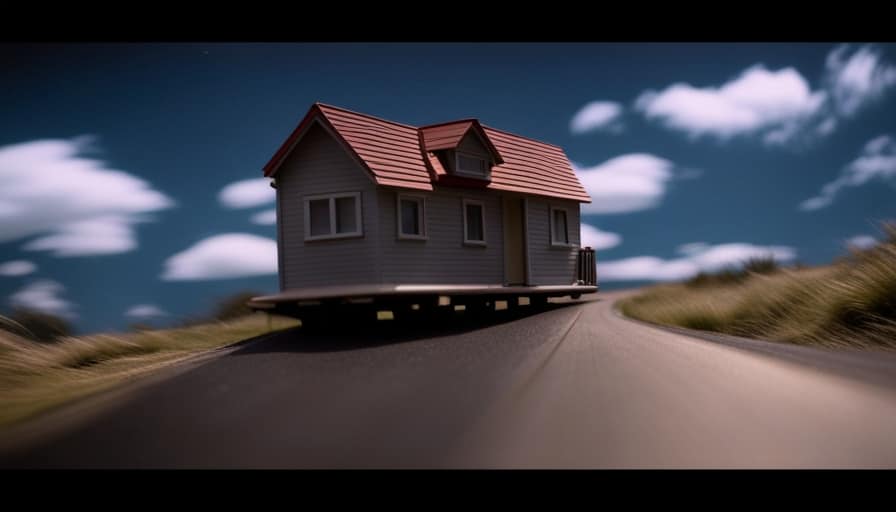
Here are some key features of our compact and functional kitchen:
-
Smart Storage Solutions
-
Built-in shelves and cabinets that utilize every inch of space.
-
Pull-out drawers and organizers to keep everything neat and easily accessible.
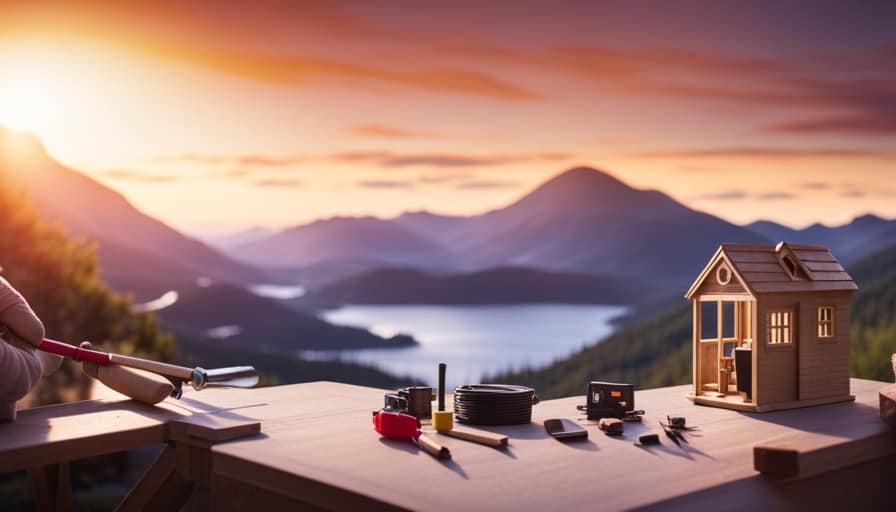
-
Compact Kitchen Appliances
-
Space-saving refrigerator and freezer combo.
-
Induction cooktop and compact oven for all your cooking needs.
With our compact and functional kitchen, you can enjoy the pleasures of cooking and entertaining without sacrificing space or functionality.
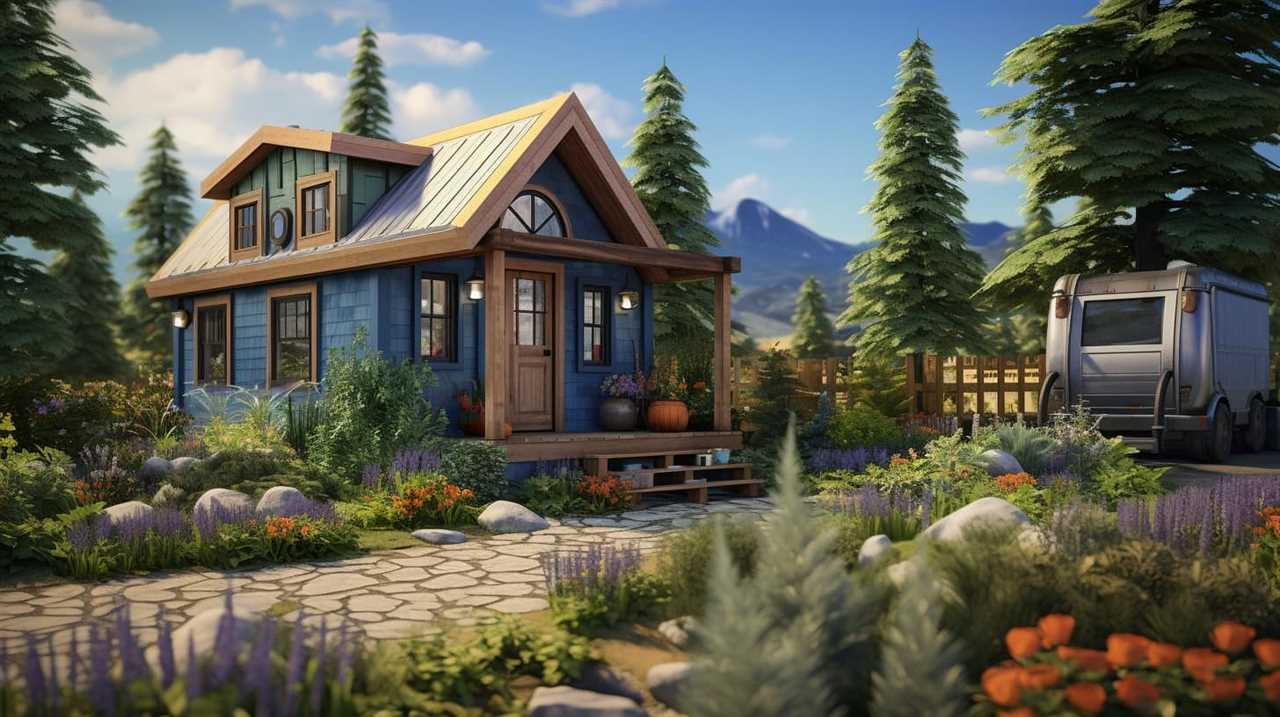
Multi-Purpose Furniture
When it comes to designing a tiny home, one of the key elements to consider is multi-purpose furniture. Space-saving furniture options are essential in maximizing small living areas, allowing for functional and versatile designs.
From convertible sofas to folding tables, these furniture pieces are designed to adapt to different needs and provide the utmost functionality in a compact space.
Space-Saving Furniture Options
Although it may seem challenging to fit all the necessary furniture in a tiny home, there are several space-saving options available. When it comes to space-saving furniture, there are a variety of creative small space solutions that can maximize the functionality of your tiny home. Here are some space-saving storage options to consider:
-
Built-in storage: Utilize the vertical space in your tiny home by incorporating built-in shelves, cabinets, and drawers. These can be customized to fit your specific needs and can help keep your belongings organized and easily accessible.
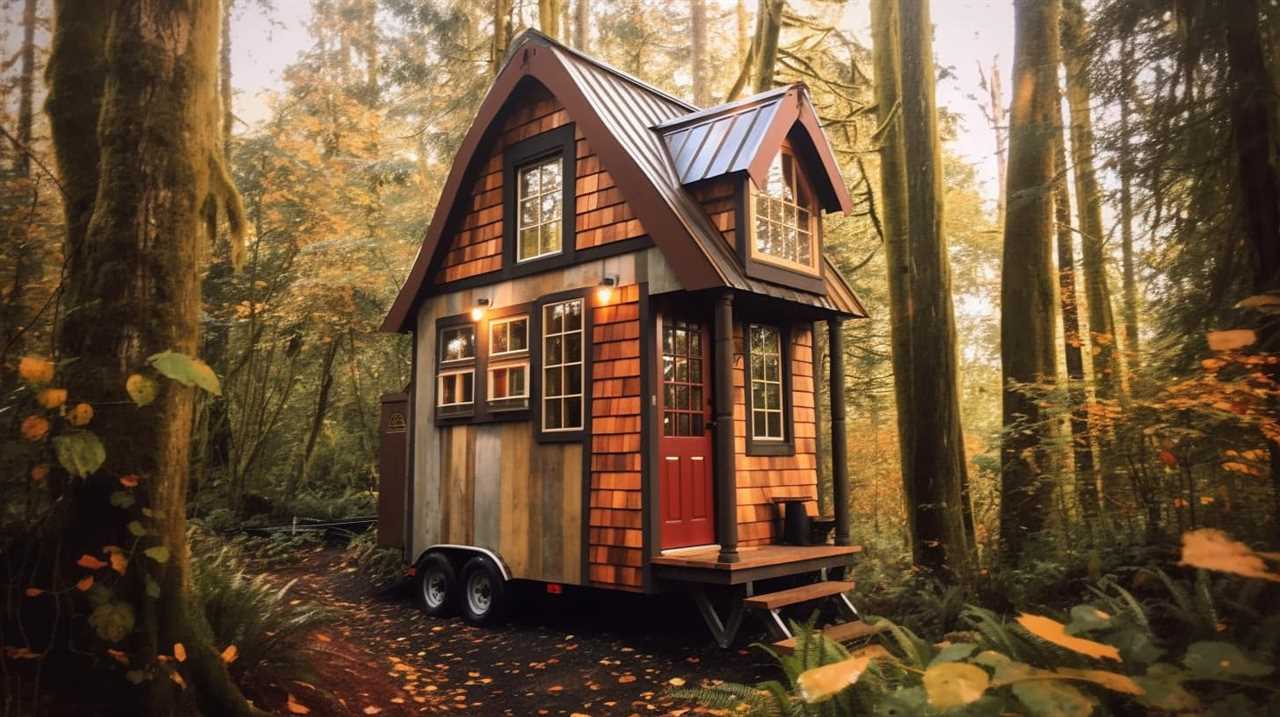
-
Multi-functional furniture: Opt for furniture pieces that serve multiple purposes. For example, a sofa that can also be transformed into a bed, or a coffee table that doubles as a storage ottoman. These versatile pieces can save you precious space while providing functionality.
Functional and Versatile Designs
We can maximize the functionality of our tiny home by incorporating multi-purpose furniture designs. When living in a small space, it’s crucial to make the most out of every inch. That’s where versatile storage options and innovative space-saving designs come in.
One example is a sofa that can transform into a bed, providing a comfortable sleeping area without taking up extra space. Another option is a coffee table with hidden compartments, offering additional storage for books, blankets, or other belongings.
Wall-mounted shelves and foldable dining tables are also great choices to save space while still providing functionality. By investing in multi-purpose furniture, we can ensure that our tiny home is both practical and efficient, making the most of every square foot.
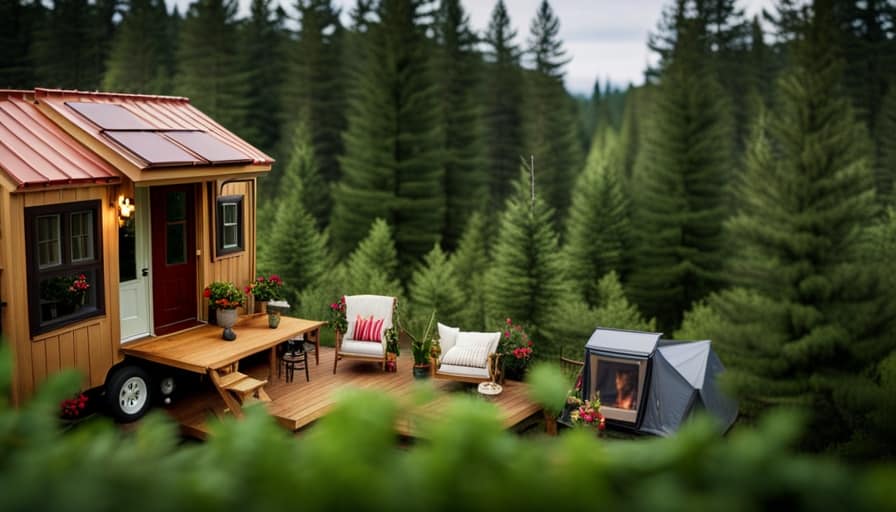
Maximizing Small Living Areas
To optimize small living areas in our tiny home, we should consider incorporating multi-purpose furniture designs. These innovative pieces of furniture serve multiple functions, allowing us to make the most of every inch of space. Here are some ideas for maximizing small living areas with multi-purpose furniture:
-
Convertible sofa beds: These sofas can easily transform into beds, providing a comfortable sleeping space at night and a cozy seating area during the day.
-
Foldable dining tables: These tables can be expanded when needed and folded down when not in use, saving valuable floor space.
-
Storage ottomans: These ottomans serve as a seating option while also providing hidden storage for items like blankets, books, or toys.
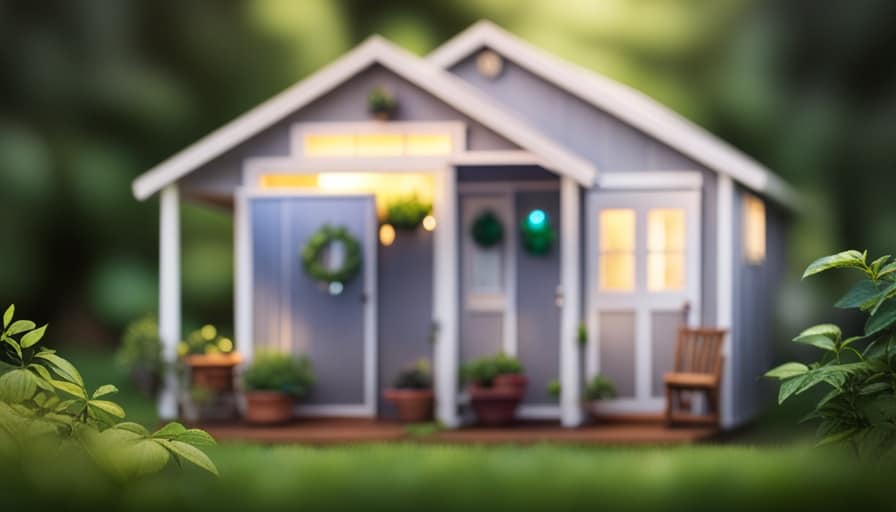
-
Wall-mounted desks: These desks can be folded up against the wall when not in use, creating more room to move around.
-
Built-in storage beds: These beds have built-in drawers or shelves underneath, offering ample storage space for clothing, bedding, and other items.
Efficient Use of Vertical Space
We always strive to maximize the efficient use of vertical space in our tiny homes on wheels. One of the ways we achieve this is through vertical gardening, which allows our homeowners to grow their own herbs and vegetables without taking up valuable floor space. We also incorporate clever loft bed designs that provide a comfortable sleeping area while freeing up room below for other activities. To help you visualize the efficient use of vertical space, here is a table showcasing some of our favorite space-saving features:
| Feature | Description |
|---|---|
| Vertical gardening | Hanging planters and wall-mounted shelves allow for the cultivation of plants in small spaces. |
| Loft bed designs | Raised sleeping areas create additional storage or living space underneath. |
| Wall-mounted storage | Utilizing vertical wall space for storage helps keep the floor area clutter-free. |
Off-Grid Power and Water Systems
While living in a tiny home on wheels, it’s important to have off-grid power and water systems in place. These sustainable living options ensure that you have access to essential resources no matter where your tiny home takes you. Here are some key features to consider:

Off-grid power systems:
- Solar panels: Harness the power of the sun to generate electricity for your tiny home.
- Battery storage: Store excess solar energy for use during cloudy days or at night.
Off-grid water systems:
- Rainwater collection: Collect and filter rainwater for everyday use, reducing your reliance on traditional water sources.
- Composting toilets: Minimize water usage and create nutrient-rich compost for your garden.
By incorporating off-grid power and water systems into your tiny home, you can live sustainably and enjoy the freedom of being self-sufficient.
Now, let’s move on to the next section: the well-designed bathroom.
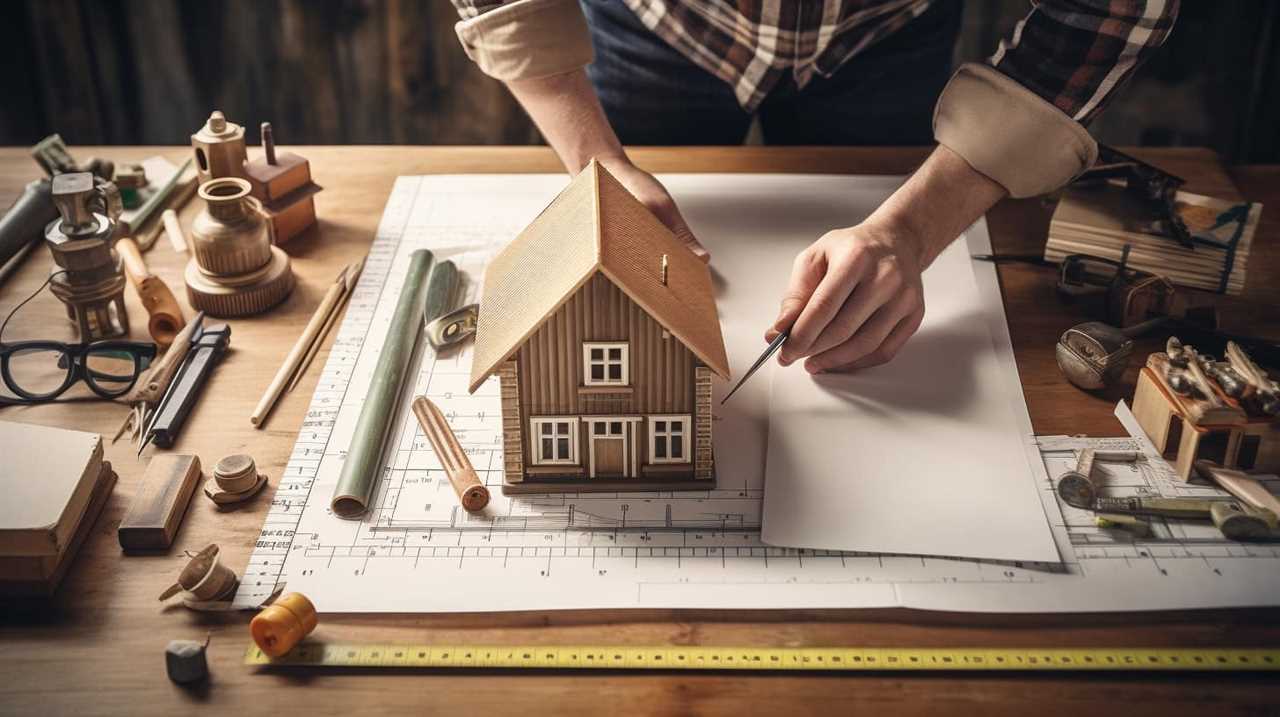
Well-Designed Bathroom
When it comes to designing a well-functioning bathroom in a tiny home, space-saving fixtures and efficient storage solutions are essential. Maximizing every inch of the bathroom is crucial to ensure convenience and functionality.
From compact toilets and showers to clever storage options like built-in shelves and hidden cabinets, a well-designed bathroom in a tiny home should prioritize functionality without sacrificing style.
Space-Saving Bathroom Fixtures
Our top recommendation for a well-designed bathroom in a tiny home is to incorporate space-saving fixtures. In a small space, maximizing storage is essential, and there are several clever solutions available. Here are some ideas to consider:
-
Space-saving bathroom storage
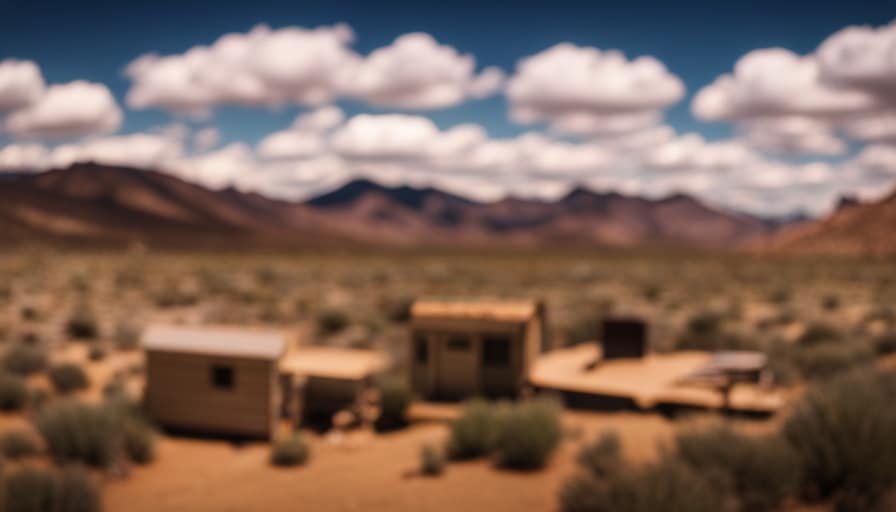
-
Utilize vertical space with wall-mounted shelves or cabinets.
-
Install a recessed medicine cabinet to save valuable wall space.
-
Compact toilet options
-
Choose a wall-hung toilet that takes up less floor space.

-
Consider a composting toilet that eliminates the need for plumbing.
Efficient Storage Solutions
For a well-designed bathroom in our tiny home, we need to incorporate efficient storage solutions that make the most of the limited space available.
Customized organization is key when it comes to maximizing storage in a small bathroom. One great option is to install shelves or cabinets with adjustable heights, allowing you to modify them according to your needs.
Utilizing vertical space is also crucial, so consider adding floating shelves or wall-mounted storage units.

Another idea is to incorporate hidden storage options, such as installing a vanity with drawers or cabinets that can hold toiletries and other bathroom essentials.
Additionally, utilizing the space behind the bathroom door with an over-the-door organizer or hooks can provide extra storage for towels or robes.
Climate Control and Insulation
We should prioritize having proper climate control and insulation in our tiny home to ensure comfort and energy efficiency. In a small space, it’s crucial to maintain a comfortable temperature throughout the year, whether it’s scorching hot or freezing cold outside.
Here are some key considerations:
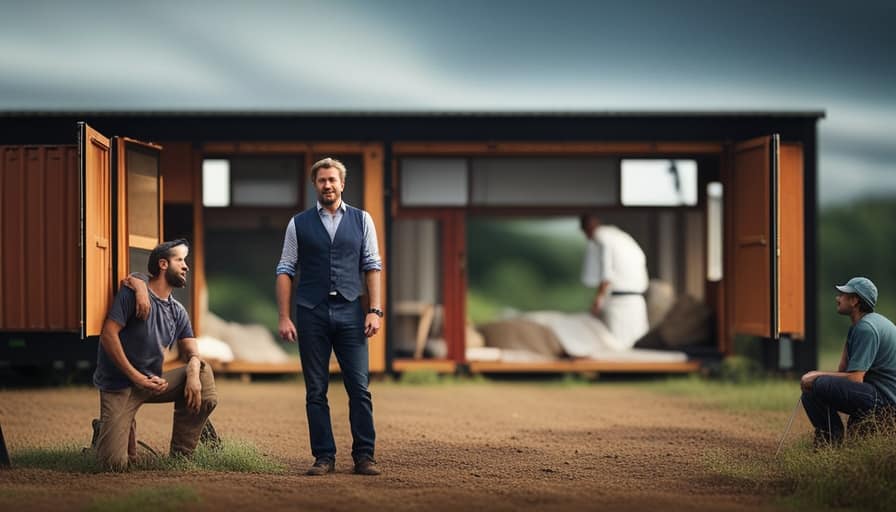
-
Insulation:
-
Invest in high-quality insulation materials to prevent heat transfer and maintain a consistent temperature inside.
-
Opt for sustainable materials like recycled denim or wool, which have excellent insulation properties and reduce environmental impact.
-
Energy Efficiency:
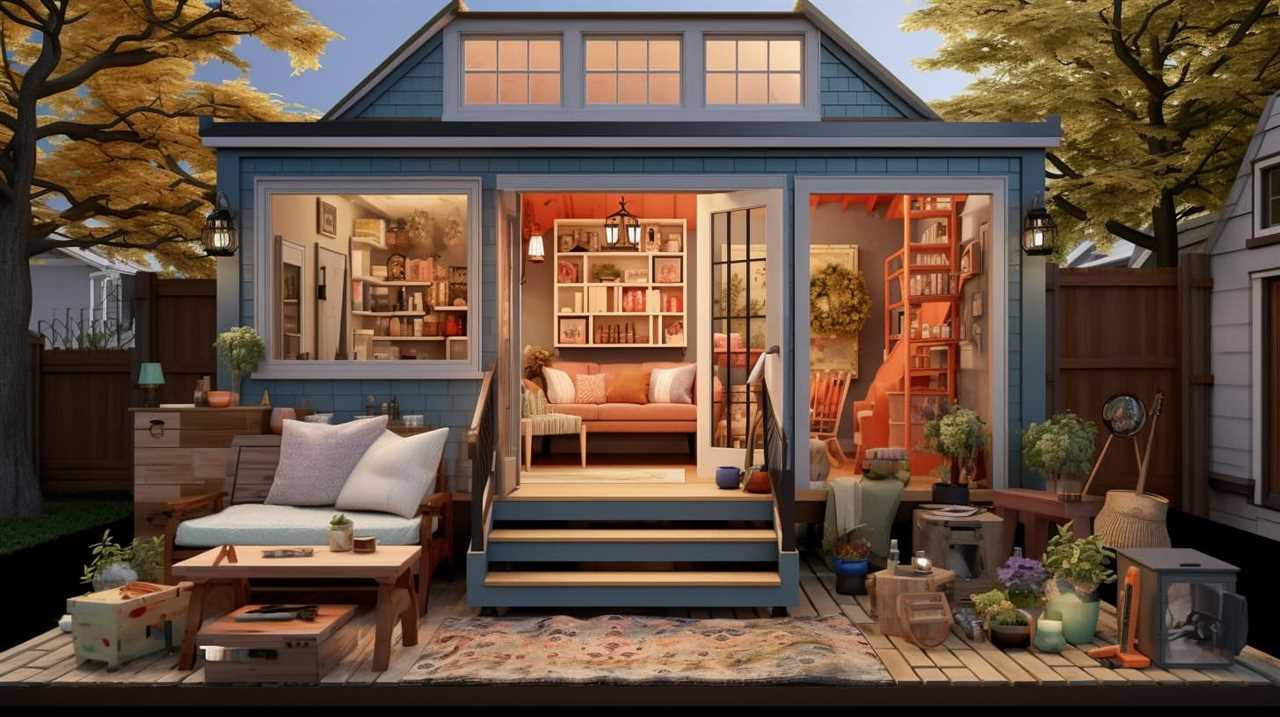
-
Install energy-efficient windows and doors with good seals to minimize air leakage.
-
Use programmable thermostats and efficient heating and cooling systems to regulate temperature and save energy.
Having proper climate control and insulation not only ensures a comfortable living environment but also reduces energy consumption, making your tiny home more sustainable.
With these features in place, we can now move on to discussing the importance of secure and sturdy construction.
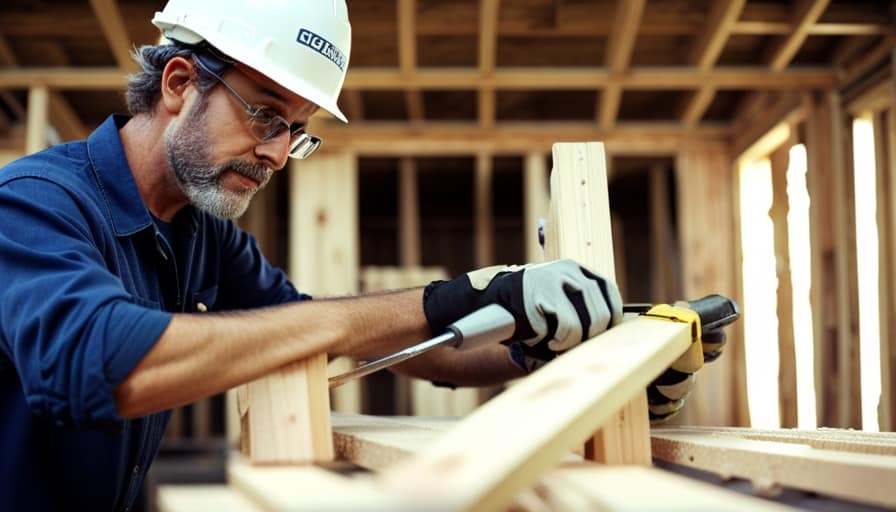
Secure and Sturdy Construction
Let’s ensure that our tiny home has secure and sturdy construction to withstand the challenges of life on the road.
When it comes to building a house on wheels, having a strong and durable foundation is essential. It’s important to choose materials that aren’t only lightweight but also provide the necessary support and stability.
A sturdy foundation will help your tiny home withstand the bumps and vibrations of travel, ensuring that it stays intact and secure.
Additionally, secure construction means using quality hardware, such as heavy-duty bolts and screws, to ensure that all components are tightly secured together.
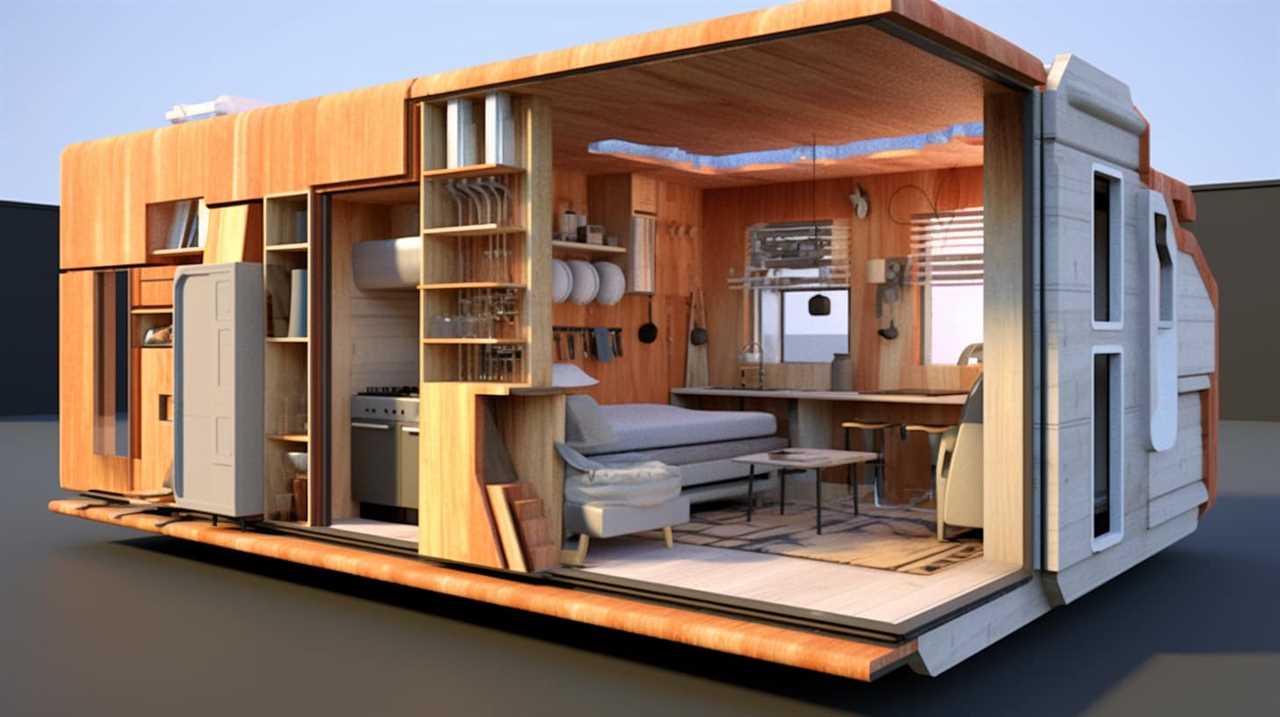
Mobility and Easy Towing
Our tiny home must have a lightweight design and aerodynamic features to ensure easy towing and maximum mobility. To achieve this, we’ll incorporate the following features:
-
Lightweight materials: By using lightweight materials such as aluminum and fiberglass, our tiny home will be easier to tow and maneuver, reducing the strain on the towing vehicle.
-
Streamlined shape: A sleek and aerodynamic design will minimize wind resistance, making it more fuel-efficient and easier to tow at higher speeds.
-
Sturdy construction: While prioritizing mobility, we also understand the importance of durability. Our tiny home will be built with quality materials and construction techniques to withstand the rigors of the road.

-
Easy maintenance: We’ll design our tiny home with accessible components and systems, making it easier to maintain and repair.
Thoughtful Design for Comfort and Style
When it comes to designing a tiny home on wheels, thoughtful design is key to creating a comfortable and stylish living space.
One important aspect of this is incorporating multifunctional furniture solutions that maximize the use of limited space.
From convertible sofas to folding tables, these clever designs allow for easy transformation and adaptability, ensuring that every square inch is utilized efficiently.
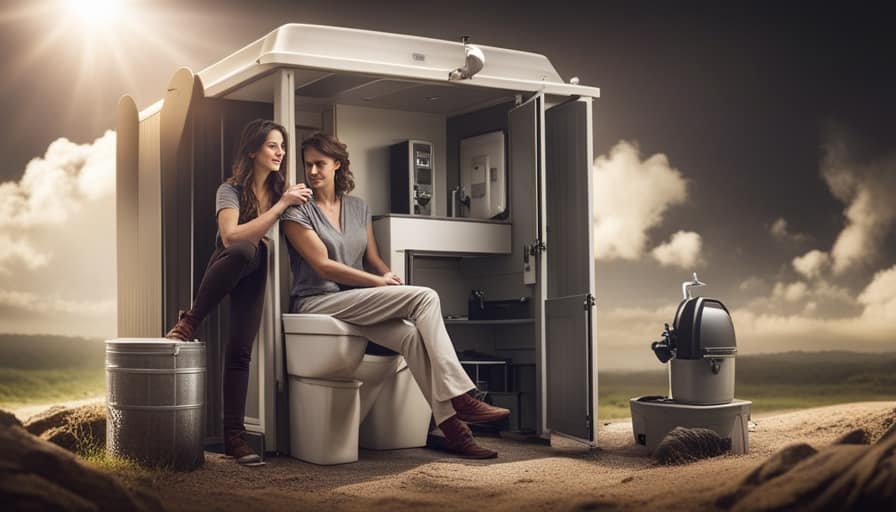
Multifunctional Furniture Solutions
We love incorporating multifunctional furniture into our tiny homes to maximize space and functionality. With limited square footage, it’s crucial to utilize every inch wisely.
Flexible seating options are a must-have for tiny homes, as they allow for easy transformation of spaces. From convertible sofas that turn into beds to collapsible dining tables that can be tucked away when not in use, these pieces provide versatility and convenience.
Additionally, hidden storage compartments are essential for maintaining a clutter-free space. From ottomans with hidden compartments to built-in storage benches, these clever solutions help keep belongings organized and out of sight.
By incorporating multifunctional furniture with flexible seating options and hidden storage compartments, we can create a harmonious living space that’s both stylish and practical.
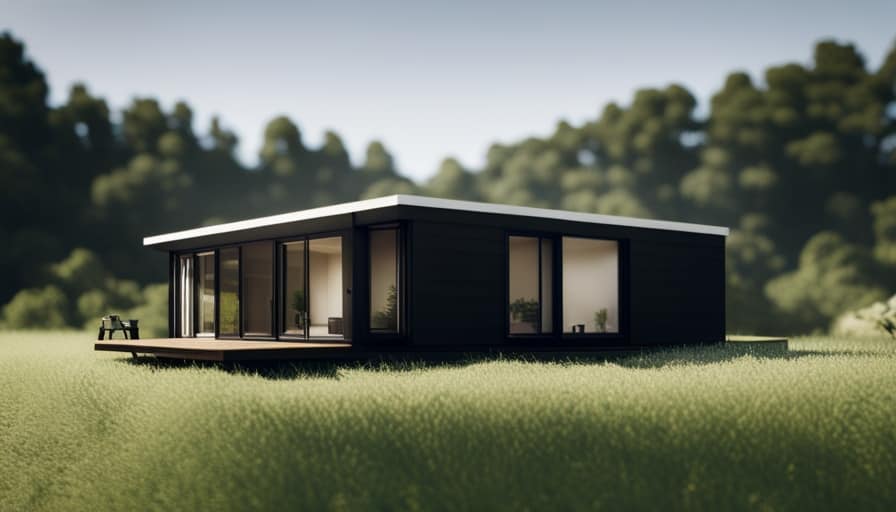
Now, let’s move on to the next section and explore the efficient use of space.
Efficient Use of Space
Let’s prioritize the optimal arrangement of furniture and the strategic placement of storage solutions to ensure a comfortable and stylish living space in our tiny home. When it comes to efficient use of space, it’s important to consider space-saving furniture ideas and creative storage solutions.
One great option is to invest in multifunctional furniture pieces, such as a sofa that can convert into a bed or a table that can fold down when not in use. These pieces maximize functionality while minimizing the amount of space they occupy.
Additionally, utilizing vertical space is key in tiny homes. Consider installing shelves or cabinets that reach up to the ceiling, or using wall-mounted organizers for smaller items.

Frequently Asked Questions
How Much Does a Tiny Home on Wheels Typically Cost?
Typically, a tiny home on wheels can cost anywhere from $20,000 to $100,000, depending on factors such as size, materials, and customization. Conducting a cost analysis and considering your budget is crucial before embarking on this exciting journey.
What Are the Legal Requirements for Parking and Living in a Tiny Home on Wheels?
When it comes to legal requirements for parking and living in a tiny home on wheels, zoning regulations and building codes play a crucial role. It’s important to understand these regulations to ensure a seamless and compliant living experience.
Can a Tiny Home on Wheels Withstand Extreme Weather Conditions?
Yes, a tiny home on wheels can withstand extreme weather conditions. Key factors include proper insulation, materials designed for extreme weather, off-grid capabilities, and heating/cooling solutions. Design considerations, durability of construction, and maintenance requirements also contribute to storm resistance and mobility during extreme weather.
Are There Any Restrictions on the Size and Weight of a Tiny Home on Wheels for Towing Purposes?
There are regulations and weight limits for towing a tiny home on wheels. It’s important to consider these restrictions to ensure safe transportation and avoid any legal issues.
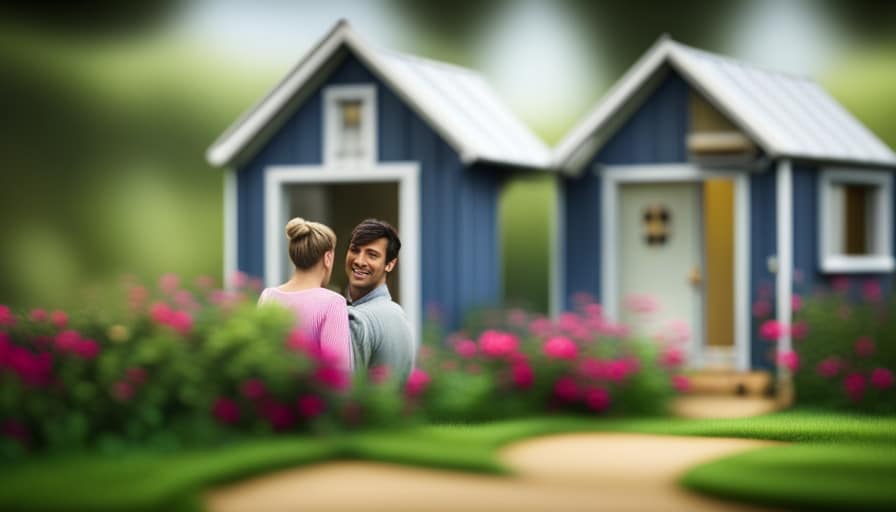
What Are the Financing Options Available for Purchasing a Tiny Home on Wheels?
When it comes to financing options for a tiny home on wheels, there are several routes to consider. From personal loans to RV loans, each option has its pros and cons.
Conclusion
In conclusion, when it comes to designing a tiny home on wheels, it’s crucial to prioritize:
- Smart storage solutions
- A compact and functional kitchen
- Multi-purpose furniture
- Efficient use of vertical space
- Off-grid power and water systems
- Climate control and insulation
- Secure and sturdy construction
- Mobility and easy towing
- Thoughtful design for comfort and style
As the saying goes, ‘A well-designed tiny home is like a Swiss army knife, packing functionality and elegance into a small space.’
I’m Theodore, and I love tiny houses. In fact, I’m the author of Tiny House 43, a book about tiny houses that are also tree houses. I think they’re magical places where imaginations can run wild and adventures are just waiting to happen.
While tree houses are often associated with childhood, they can be the perfect adult retreat. They offer a cozy space to relax and unwind, surrounded by nature. And since they’re typically built on stilts or raised platforms, they offer stunning views that traditional homes simply can’t match.
If you’re looking for a unique and romantic getaway, a tree house tiny house might just be the perfect option.
